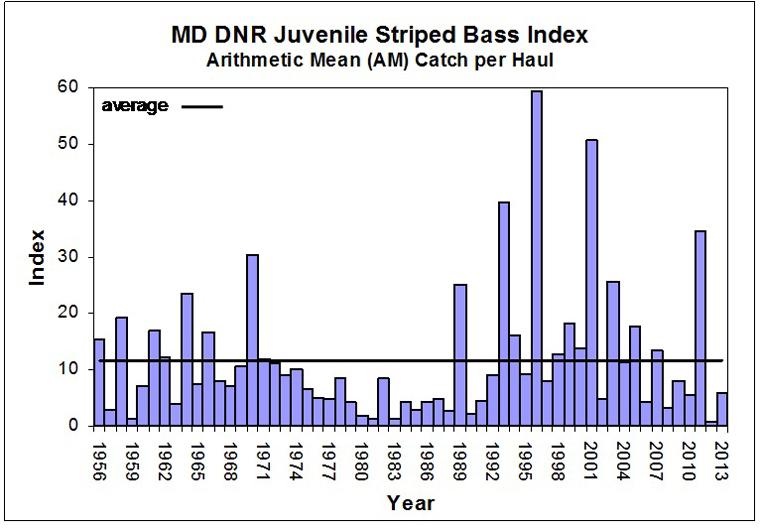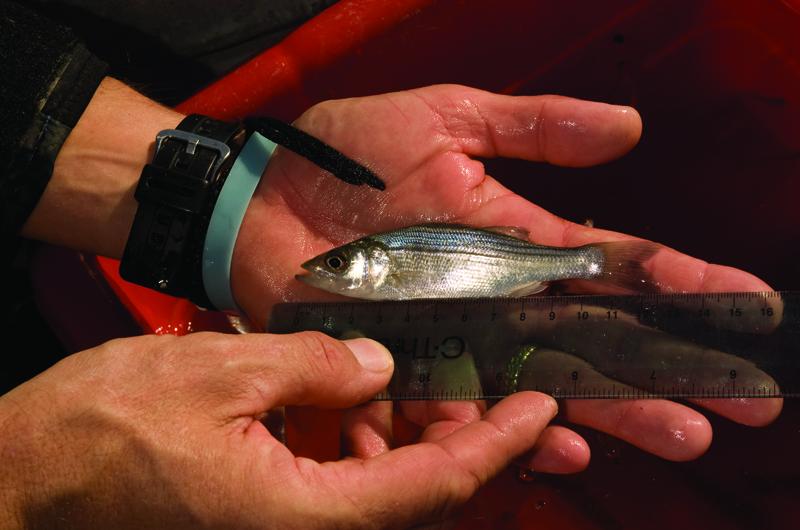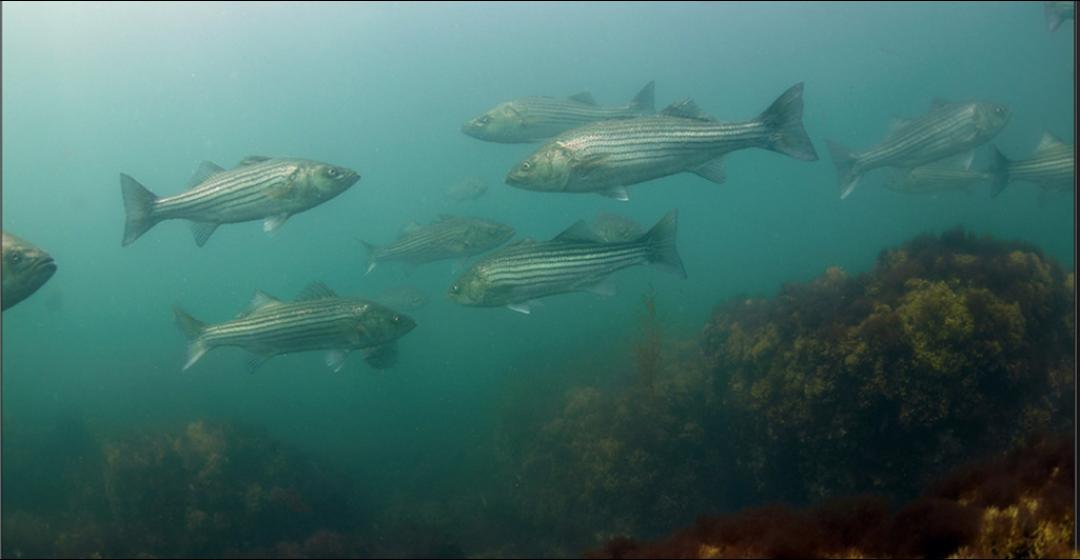Scuttlebutt and bad news have the tendency to travel faster than good news or the real facts. That’s human nature and nowhere is it truer than around the docks, where all anglers become possessive about their favorite quarry. When something changes for striped bass, New England’s premier sport fish, and that change is perceived to be bad news, you can be sure the sky will soon be predicted to fall.
As this is being written, there is a sense that “the sky is falling.” Stripers are anadromous fish, meaning they breed in fresh water and live most of their mature lives in salt water. The fish we see around the Cape and Islands spawn in the Chesapeake Bay, and to a much lesser extent in the Hudson River, and migrate up the coast to Maine and beyond. At one time there may have been small local populations that bred in New England rivers, but industrial development extirpated virtually all of those stocks. Stripers can live to thirty years; the largest on record was a 125-pound female caught off North Carolina in 1891. On the Island, the largest fish entered in the Martha’s Vineyard Striped Bass and Bluefish Derby was a sixty-pound lunker caught by Dick Hathaway in 1978, though there is anecdotal evidence of larger fish that were not entered.
For many on the Vineyard and around the Northeast, the spring arrival of stripers is nothing short of a religious experience, and when something happens to delay or change that experience the news impacts the entire year’s fishing season. Perception soon becomes reality. Bad news is jet fuel for the internet, and by mid-summer alarmed anglers on the waterfront and the internet are howling: “Where are the fish? They haven’t arrived here yet.” “Is the population crashing?” “There aren’t any big fish.” “There aren’t any small fish!” “There aren’t any freaking fish at all!”
All of this is happening with striped bass now, at a time when some thought we might have turned a corner and headed in a sustainable direction. Overfishing and poor environmental conditions led to the collapse of the fishery in the 1980s, but through intensive management by the Atlantic States Marine Fisheries Commission the stocks began to rebound. Some states implemented moratoria on striper fishing; Massachusetts was not one of them, but between 1985 and 1993 the derby did its part by not including bass in the tournament. By 1995, the striper population was considered to be fully restored.
So what is the problem today? Or more accurately, what are the problems? Not surprisingly for a migratory fish that relies on both rivers and the ocean and is fished by both commercial and recreational anglers, there are multiple factors involved. And as is often the case for an environmental issue, one’s opinion on which factor plays the largest role often depends on one’s particular perspective and bias. We all see things through our own eyes. The factors include, but are not limited to, several years of poor spawning success, too much fishing pressure on mature – eight-years-old and up – fish, and habitat and forage issues.

Every year for the past fifty-nine years fisheries scientists in the breeding grounds of the Chesapeake have trapped and counted juvenile striped bass in haul seines employed at the same sites in order to get an idea of long-term trends in the striper population. Through various statistical calculations they then come up with a number called the Young-of-the-Year Index, which is released annually in early October. The 2012 index value (.89) was the lowest ever recorded, and the index for 2013, while better at 5.8, was still well below the sixty-year average of 11.7. Of the past five years, only one was above average. By contrast, the highest ever-recorded index was 17.61 in 1996. (At the time of publication, the 2014 Young-of-the-Year Index had not been released.)
This poor spawning and subsequent low recruitment into the fishery means that no matter what action is taken to try to revive the stocks in the near term, there will be some lean years coming along, although anglers should be seeing some of the 2011 schoolies in local waters. To some of us who lived through the striped bass decline in the 1970s and ’80s, this has a very familiar feeling to it.
However, even with these record poor spawning numbers, the managers today seem not to be concerned and have not taken any radical action at this time. Why is it that they are outwardly comfortable with where the population signs are pointing? There are a couple of important differences with the fishery today and when it last crashed. For one thing, there are a lot more eligible mothers in the striper population today. In 1982 the spawning stock biomass (SSB), as the population of mature female fish is called, was approximately 10 million pounds. Today it is in the neighborhood of 127 million pounds.
These are the fish that are capable of producing the future generations, and fisheries managers are taking comfort in the knowledge that less than a tenth that many fish in 1982 was able to start a stock rebuilding that culminated in an SSB of almost 170 million pounds in 2004. So, the thinking goes, if a population of 10 million pounds could grow to almost 170 million pounds in twenty-two years, today’s 127 million pound spawning stock should be able to maintain a viable population. Agreed, but it still feels an awful lot like a repeat of what happened. And, of course, one has to have confidence in stock assessment numbers.
But why was the spawning success so low over the past decade when there should have been enough spawning fish to produce at least an above average amount of juveniles? The Maryland Department of Natural Resources points a finger at the weather conditions, saying that with near-record low water in the upper reaches of the Chesapeake Bay it has been too dry for the fish to spawn. Low water also impacts the temperature of the water, which is another critical component of larval survival. Ironically, perhaps, it should also be noted that environmental conditions on the spawning grounds were blamed for the downturn in the species in the late 1970s. Only then it was too much rain that supposedly washed a high level of contaminants into the bay, which impacted the survival of the larval fish.
In other words, it’s a bit of a Goldilocks syndrome: not too wet and not too dry, the fish need it just right. It’s not comforting, therefore, that climatologists nearly universally agree that weather patterns are going to be more variable in the future. This is bound to have substantial impacts on a wide variety of species that use estuarine and riverine habitats for spawning, including striped bass. Managers may have every reason to believe that with the current large stock of spawning-age females they have enough margin to compensate for unforeseen future events, but the truth is they are looking at past events in an effort to determine what is likely to be a very different future. There is a greater chance for error as species try to adapt to an increasingly variable environment.
So while the sky may not be falling on the striper population just yet, there is ample reason to be concerned about the apparent wait-and-see strategy of the current fisheries managers. This is even more true when you consider that, given the typical three-year lag between the Young-of-the-Year Index and the arrival in local waters of fish from that year-class big enough to keep, all the fishing pressure for a few years will be on what we call the BOFs, or big old females. With fewer small fish recruiting into the fishery, anglers will predominantly be targeting the available BOFs, which under current management are of legal size. These big old females, not surprisingly, are vital to the future of spawning success.
So, what does this all mean? Well, I believe it means that fisheries managers need to think differently about this fish. They need to think beyond managing stripers simply as a volume commodity and think about the fish as a quality-based experience for a substantial number of users who can and will generate a very valuable economic benefit to the nation. The current estimate is that the recreational striped bass fishery generates $6.63 billion in economic activity, while the commercial bass fishery is worth only $250 million. Put another way, there are roughly 3 million participants in the recreational fishery, which is roughly 300 times the number of people who fish for bass commercially.

My long experience in fisheries management has led me to the conclusion that managers are in a no-win situation when they have to answer to competing constituencies, recreational and commercial. Ultimately, commercial users want numbers of fish to fill their quota, while recreational fishermen want a quality experience with the opportunity to make a once-in-a-lifetime catch. One goal is not better than the other, but the management regimes are different and incompatible. Ideally, fisheries managers should be concerned only about the resource, but we live in the real world, folks. If it’s impossible to reconcile the competing interests and still protect the fish, the only important thing that can be done by resource managers is for Massachusetts to follow the lead of Maine, New Hampshire, Connecticut, New Jersey, Pennsylvania, and South Carolina and eliminate the commercial season altogether. It’s time to make stripers a game fish.
Okay, I’ve stepped into it. Some think that fisheries managers don’t take the game fish concept seriously and therefore it is a waste of time to even talk about it. Also, many believe that game fish status won’t have any fish mortality benefits, since recreational anglers will be happy to catch and keep any fish formerly taken by commercial boats. Both good points! I happen to agree that many fisheries managers don’t want to take game fish status for striped bass seriously because they view their job as serving all the stakeholders. On the other hand, plenty of other fish species are managed just for commercial or just for recreational use. As already mentioned, there are many states that already have moved to game fish status for stripers.
As far as fish mortality is concerned, I agree that eliminating the competition of interests between commercial and recreational anglers will not, in itself, reduce mortality in the striper population. But it will make the job of adjusting the mortality rate significantly less complicated. More important, it will change how managers view this fishery, and move the management process toward focusing on a quality fishery, with a normal distribution of age classes. With game fish status, managers can implement what’s known as a “slot limit,” where anglers can keep smaller fish than they currently are allowed, but will have to release larger fish.
The major benefit of a slot limit is it moves the vast majority of the catch away from the BOFs. Fish over twenty-eight inches, the current minimum size limit for anglers in Massachusetts, are predominantly female and sexually mature. So, perversely, the current management policy in most states focuses all the fishing pressure on the very fish needed to make sure that there is strong recruitment in the future.
A slot limit, on the other hand, would move some of the mortality to smaller fish, which are not only more plentiful, but have a higher level of natural mortality than those fish over twenty-eight inches. In other words, let’s let anglers keep more fish that are otherwise going into the bellies of seals. Furthermore, the current mortality among fish that are caught and released is concentrated in undersized fish; for a number of years in Massachusetts, the recreational release mortality exceeded the commercial catch. A slot limit will convert some of the unsuccessfully caught and released small fish into
keepers, sending an angler home for dinner who might otherwise stay half the night trying to catch a Big Old Female.
Do I exactly know what the slot should be? No, I do not, but I suspect it should be somewhere between twenty and thirty inches. So, once those fish get bigger than the upper limit, we protect them. What about the derby, you might ask? Or the big lunker on the wall? It might be possible to have a trophy fishery for those over forty inches that could be controlled with a tag system. However, there is such concern about quota management that the tag concept might freak people out. In today’s world, I don’t understand why folks cannot simply take some measurements and photos and get a reproduction mount for that catch of a lifetime. As for edibility, those big fish are very poor eating compared with a twenty-four inch fish.
Some may think that this effort is only an anti-commercial push that blames commercial exploitation for all the problems with striped bass. It is not intended to be. The primary point to make is that the fish do not care who kills them. A dead fish is a dead fish. Everyone who catches striped bass needs to recognize that he or she has an impact. But I do believe that managing for two different user groups changes the management philosophy, in my opinion, to the detriment of the resource.
There is also the argument that since environmental conditions often dictate the level of spawning success, you don’t have to protect all those BOFs. But with striped bass and many of the other species that anglers like to chase, what we can expect is the unexpected. We are going to have more variability in weather extremes, which will impact the forage base. The forage base will determine where the fish are. We therefore need to have as much of a buffer as possible. Why not have as many BOFs as possible to produce an off the charts Young-of-the-Year Index?
I simply see no reason why game fish and slot limits for striped bass cannot work. In fact, they would work better together and would go a long way to helping maintain this fishery and produce the highest economic benefit to the nation. They would also make a quality experience that is sustainable and still allow people the opportunity to take home a wild-caught meal.
Do I think that striped bass are on the verge of a collapse like in the late 1970s and early ’80s? If the assessment is anywhere near correct, I do not. If the numbers are incorrect, it will be one of the biggest fisheries science blunders in history, with a species that has been the subject of more research and studies than just about any other finfish.
But does this mean that the collective we can put the ship on autopilot and lounge around? Not likely! We know there are icebergs out there and now is the time to be turning the wheel. In fisheries management issues, I am often reminded of Henry Bigelow’s quote, “The price of strong marine resources is constant vigilance.” All of us who care need to be constantly watching and participating in the management process. Don’t always rely on the other guy to do it.





